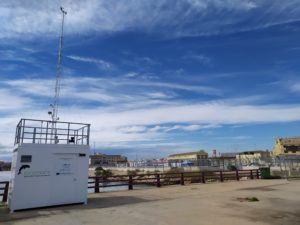
The details of the two cabins can be consulted from today on the website valenciaport.com or on the website of Conselleria de Agricultura, Desarrollo Rural, Emergencia Climática y Transición Ecológica
The measurement facilities are located in the old Turia riverbed and the Poniente cross dock and record eight elements of different gases and particles to analyze air quality, among other parameters.
These two cabins, plus the one installed in the Port of Sagunto, are Ecoport certified and are equipped with the latest technology for measurement and control.
The Port Authority of Valencia was the first Spanish port and the second European port to achieve EMAS registration, the most demanding certificate in environmental management and auditing.
From 2008 to 2019 the carbon footprint of the Port of Valencia has been reduced by 30% while the activity grew by 42%.
From today you can consult in real time and from the APV website the information provided by the two air quality measurement booths located in the Port of Valencia. Specifically, today are added to the web of Valenciaport and also to the web of the Conselleria de Agricultura, Desarrollo Rural, Emergencia Climática y Transición Ecológica the data collected by the facility located in the Transversales de Poniente dock (in front of the Cabanyal neighborhood).
The measurements taken by the cabin located on the esplanade of the old Turia riverbed (in front of the Natzaret neighborhood) could be consulted in real time for some months on both websites. Thus, only the one located in the Port of Sagunto has yet to be incorporated into the APV system.
The three control facilities are equipped with the latest technology for measuring and controlling atmospheric pollutants. They have five gas analyzers that measure the concentration of sulfur dioxide (SO2), nitrogen oxides (NO2/NO/NOx), ozone (O3), carbon monoxide (CO) and PM10 and PM2.5 particles. In addition, they include pollutant gas and particle parameters (8 different elements) and meteorological indicators (8 other data sources), as opposed to other booths that only include the measurement of PM10 and PM2.5 particles.
In addition to this technology, they are also a weather station, for observation and recording of wind speed and direction, rainfall, solar radiation, temperature, relative humidity, and barometric pressure, and include sound level meters to measure the port’s acoustic levels.
Regarding the selection of the locations of the cabins (the two in Valencia and the one in Sagunto), they were decided based on the criteria and indications of the technicians of the Environmental Studies Center for the Mediterranean (CEAM). The data they compile are complemented with those obtained by the seven new environmental sensors to complement the current equipment. The objective of the Port Authority of Valencia with this deployment is to reinforce its commitment to sustainability through innovative solutions that make it possible to analyze aspects such as air quality, and to offer information to the port community and the Port’s neighbours in an active and periodic manner.
Commitment to the environment
Valenciaport is part of the “EcoPorts” network of ports, which is the main environmental initiative of the European port sector and aims to improve environmental management and raise awareness of environmental protection through cooperation and knowledge exchange between the different ports.
The APV also complies with all international environmental quality standards, including the EMAS regulation, the most demanding certificate in terms of environmental management and auditing. In fact, Valenciaport was the first Spanish port and the second European port to achieve this accreditation in 2008, and it is the only port in the Valencian Community that is registered in the EMAS registry of the Ministry of Agriculture.
All this is complemented by PERS certification (the only environmental management standard specific to the port sector) which incorporates, in addition to the main general requirements of recognized standards (such as ISO 14001), port specifications based on ESPO recommendations, which are audited by an independent and internationally recognized firm such as Lloyd’s Register.
Decarbonization
The environmental certifications are in addition to the fact that the APV was the first port authority in Spain to register the Carbon Footprint of a port facility in the Carbon Footprint register created by the Ministry of Ecological Transition, obtaining the “Calculation” seal.
In this sense, Valencia is also a pioneer port worldwide in measuring its Carbon Footprint under the ISO 14064-1:2012 standard, a methodology that includes measurement at four levels: emissions from electricity and fuel consumption of the APV, concessionary companies, ships and land transport produced within the port area of Valencia.
From 2008 to 2019, the Port of Valencia’s carbon footprint has been reduced by 30%, from 3.19 to 2.23 kg of CO2 per ton handled. In the same period of time, Valenciaport’s activity grew by 42%, going from 52 million tons handled in 2008 to 74 million at the close of the 2019 financial year. These figures position Valenciaport as an international benchmark in port developments and strategies for decarbonization by showing with facts and figures that the growth of economic activity is not incompatible with the reduction of CO2.

